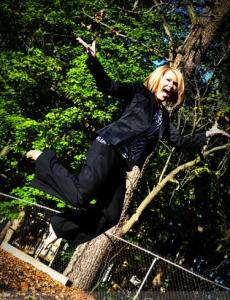Indie Authors – You CAN Do It!
By Crystal Patriarche | August 31, 2012 |
On a weekly basis, I field emails and phone calls from authors who are tackling the world of publishing alone. They have decided to self-publish their book or go  with a small press and are looking for guidance to promote it. They often ask – can you help make my book a bestseller? How can publicity help sales? What are typical sales numbers for books you represent that have no publisher?
with a small press and are looking for guidance to promote it. They often ask – can you help make my book a bestseller? How can publicity help sales? What are typical sales numbers for books you represent that have no publisher?
I start off by telling them these three things: every book is different, PR doesn’t guarantee sales and it will be an uphill battle. I am very selective with self-published books that come my way. Not because I have anything against self-publishing; but, because I won’t take a book on if I don’t think I can succeed on some level. I won’t take any book on unless I feel like I can succeed – it’s not about the number of clients for me, it’s about the work itself and if I’m a good fit for that book and author. So that I can successfully help on that uphill battle.
Most of the news about self-publishing is daunting and still very gloomy. The stigma still exists. I try not to be discouraging, but I know I need to be realistic. I had a self-published author come to me and say she wanted to sell 30,000 copies of her book. I told her she’d be lucky to sell 300. I wanted to be honest and up front. Yes, we would do all we can, but I wanted her to have realistic expectations.
But today I don’t want to be gloomy or discouraging when it comes to self or indie publishing. I want to tell you that IT CAN BE DONE! You can do it! And I want to share with you some success stories and tips – real stories of self-published authors who are not Amanda Hocking or John Locke or E.L. James.
Indie Authors – You CAN Do It!
“Indies…sometimes it feels like the weight of the success of our books rest on our shoulders. Which is true. But it doesn’t mean we have to do it alone,” says  Steena Holmes, award-winning and bestselling (yep!) self-published author of Finding Emma. “From the moment you write The End, you are responsible for the success of your book. Let’s face it. That’s a daunting reality. There are literally millions of books available for readers to pick and choose from, so how do you ensure that yours is at the front of their list?”
Steena Holmes, award-winning and bestselling (yep!) self-published author of Finding Emma. “From the moment you write The End, you are responsible for the success of your book. Let’s face it. That’s a daunting reality. There are literally millions of books available for readers to pick and choose from, so how do you ensure that yours is at the front of their list?”
There are a few things you can do right from the beginning. These are things Steena did, and my other self-published authors have done, to help them succeed. These are things I tell them they MUST do. And oh… the writer who wanted to sell 30,000 copies and I told her she’d be lucky to sell 300? She reached her goal – and then some. And Steena? She sold more copies than that in August alone. She was ranked on Amazon bestseller list with the likes of Emily Giffin, the Fifty Shades of Grey books and Hunger Games trilogy. Go Steena!
So…You CAN do it! And here are some tips how. From Steena, from my experience with BookSparks clients over the years, and from the various campaigns we’ve worked on that have had success. Not every book is the same, but there are things you MUST do and CAN do to prepare for that uphill battle.
#1 Hire a professional editor to help make your book shine. “Beta readers are awesome to have but unless you do everything possible to ensure your book is perfect, readers are going to catch your mistakes,” says Steena. “Let’s face it – Indies are under scrutiny by readers and have higher standards to meet. If you do have readers email you about errors, be professional, thank them and make the changes!”
#2 Get a professional cover to give your book its best face forward. “You do judge a book by its cover, now more so than ever. Unless you know what you’re doing and have experience, don’t put up a cover that screams DIY,” she says.
I tell all my self-pub authors to use a professional cover artist. I love Julie Metz Design and she’s created some very beautiful covers for my clients and for many publishers. Steena recommends taking a look at some covers from other indie authors and ask around or trying The Author’s Red Room – they have custom covers, ready-made covers and an editing team to help.
#3 Hire PR and marketing support. “It’s important to use someone who knows what they are doing and have a wider sphere of influence than you do. Plus, it leaves you with more time to write your next book while they do the work of getting your current book out to readers,” Steena says. “Do blog tours, hold contests and set up a Facebook page for you. These are all things someone can help you do!”
We obviously helped Steena with those things so she could focus on writing the follow up to Finding Emma, but she did so much on her own as well. And I will go a step further and say that you should not only hire someone who knows what they are doing and has influence, but find someone that is that right fit for your book. If I’m not a good fit for a book, I will be the first to say. Some publicists won’t – they just want to take on the work. To find a good publicist that’s right for you, instead of asking them “Why should I pick you as my publicist?”, ask them “Why would you pick me as a client?” Make them tell you why they would choose you and your book – it will tell you a lot!
#4 Use Amazon to your advantage! Both of my indie clients who have been bestsellers on Amazon and sold thousands upon thousands of copies, have gotten the most out of Amazon. “With their likes/tags and author page where you can add videos, blurbs, reviews and more, it would benefit you to use what they offer as much as you can,” says Steena. “With KDP Select, you can use their offered 5 days of free promotion if you like. You don’t have to – but for some authors, it has helped increase their visibility. Just be aware that if you sign up for Select, there is a 90 day exclusivity. The same can be said for Kobo and B&N.  Each have programs to help you increase your visibility.”
Each have programs to help you increase your visibility.”
#5 Reviews. Don’t buy them. You don’t have to. The very idea that there are people buying reviews is upsetting to me. If you have the right marketing and promotion strategy, the right publicist, going after the right audience, you should never have to buy a review.
“When you first launch your book, think about doing a ‘soft launch’ for 1-2 weeks. This is a perfect way to get reviews from your readers. Have a low price to entice them to buy and help you get the word out,” says Steena. “If you have a newsletter (and you should) send one out just to your readers and let them know about your new release. Post a giveaway on Goodreads, set up your page on there as soon as possible to start getting the word out about your book. The earlier can you can build the buzz for your book the better!”
I’m happy to say that Steena has not only been on the bestseller list and had great sales numbers, but she’s fielding offers for her work now. There are success stories out there. You can do it too – and I hope you do!









Such an encouraging post! Thank you, Crystal!
It’s so great to get needed information from knowledgeable insiders here on WU. Thanks for the encouraging and insightful post!
[…] Crystal Patriarche of @BookSparksPR shares indie author best practices and success stories. […]
Thanks, Crystal. This is useful advice for any self-published author .
Thank you for a very encouraging and positive post. There are some good ideas here, and it will hopefully help me in the long run for The Loss of Deference my first slef edited, self covered, and self published book on Amazon!
[…] Crystal Patriarche of @BookSparksPR shares indie author best practices and success stories. […]
These are all good tips; my own books have done reasonably well (mostly through Amazon, unsurprisingly), but could be doing better. I would like to know more about #3!
Well said! I’d like to share another indie success story I recently learned about: Terri Guiliano Long, author of In Leah’s Wake, who has sold almost 200,000 copies and has reached #6 in B&Ns bestseller’s list.
One thing to bear in mind: Terri devoted nearly an entire year full-time to her book marketing, in addition to hiring various PR and marketing firms. (Including MJ Rose, whom she raves about! Go MJ!) She now has a full-time assistant handling her marketing.
So in terms of that uphill battle, be prepared above all to put in lots of hard work and above all, TIME.
Thanks for a sane and balanced view of an insanity-producing subject. My issue is TIME–taking the time to implement good suggestions. Note to self: Post that audio of the reading I did at U Penn last winter on Amazon page. Aargh!
[…] and on a much more positive note, publicist Crystal Patriarche (@booksparkspr) announces Indie Authors–You CAN Do It on Writer Unboxed. Crystal offers five steps indie authors can take (well, four they can/should […]
[…] Indie Authors – You Can Do It! By Crystal Patriarche at Writer Unboxed […]
Great post and I can personally attest to all the hard work Steena has done to become successful. She did all the right things at the right time. And the first thing she did, that I think is key, she wrote a great book that resonates with people. Not every book will become a bestseller, and indies have to remember that. Just because you write it and market it doesn’t mean it will sell 40K.
Why Steena, how nice to see you here!
Great tips, Crystal. I have to agree with Vivi–I’ve seen a teensie bit of how hard Steena has worked, but so have many self-published authors of my acquaintance. That’s where it makes sense to pick the stories with legs and give them that extra push. Congrats to you both. It’s gotta be a great feeling when it all comes together and the readers respond.
So thankful for all the great info. Getting ready to launch book one in my romantic suspense series in January 2013. Thanks very much!
I think you have got it pretty much down perfectly here. If you take time with your book, prepare it well and don’t think that as an unheard of author you are going to sell a million straight off the bat, then there are very few downsides to being an indie author. After all, many books, and films, haven’t been truly successful until years after their release. Build an audience over time and keep writing and when new people find your work, they will be more inclined to hunt down your previous books.
I self published a book around three years ago purely because the option was available. It has sold around 100 copies, but i didn’t mind because it was a parody novel I mostly wrote for myself. I didn’t do any promotion (mainly as it is specifically tied to Christmas) so the result was expected.
My new novel, which was intended as a “proper” book was self published in October. I completed the novel back in 2011 but then spent around a year editing and reviewing it with the help of a few people to prepare it. I feel that if you don’t take the time then it does look like you don’t know what you are doing which is never going to get you dedicated readers.
I launched the book with the lowest selling price (just under £1 in the UK and I think $1.55 in the US) and have made around 50 sales with nothing more than a few blog posts and a youtube self-made trailer.
I have always written for the love of writing and creating. I write the things I like to read, so until it becomes my full time profession – which is the ultimate goal one day – I still write for the love of writing rather than income. To me as long as the quality is there, there is no reason not to charge a low cost for Kindle books in particular. The main problem is the number of badly written books and how to tell them apart.
Wonderful guidelines. If I choose to self-publish these will definately be considered and even if I should find a main stream publisher these are good tips to consider also.